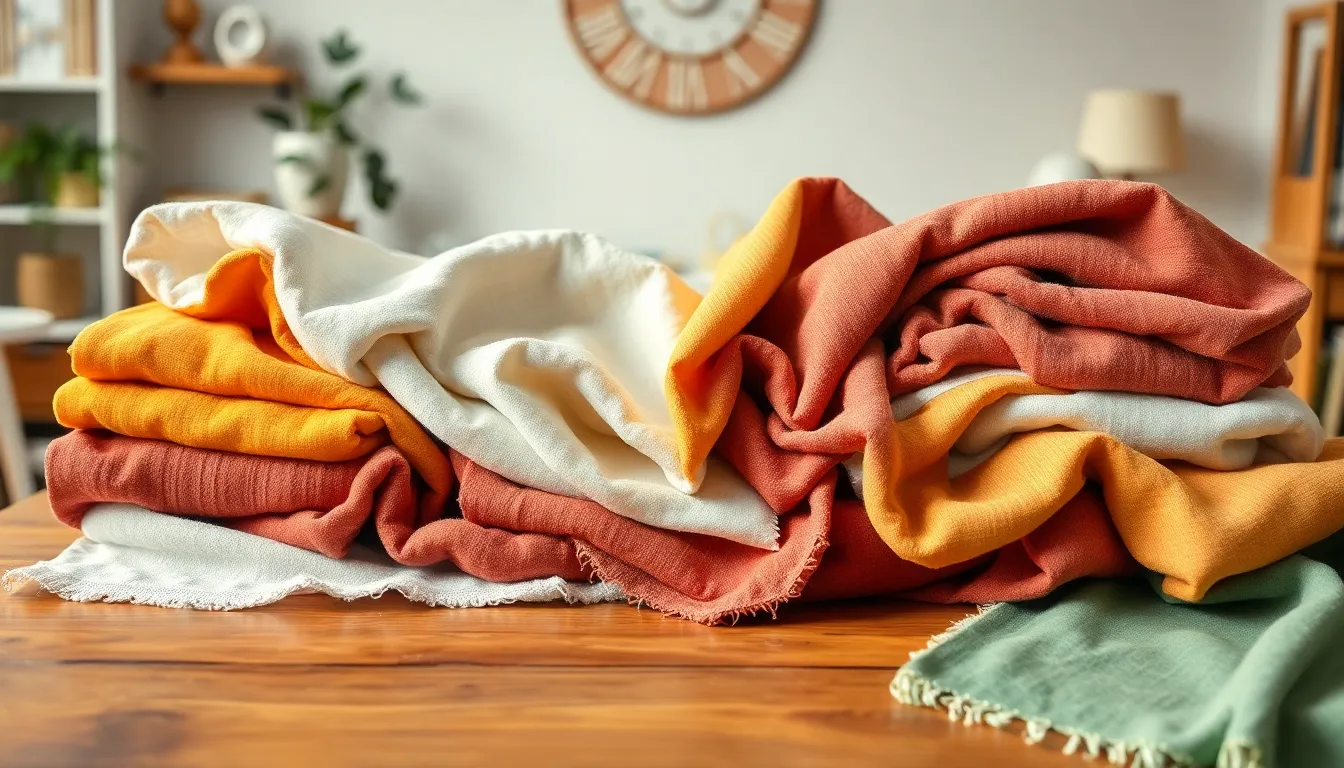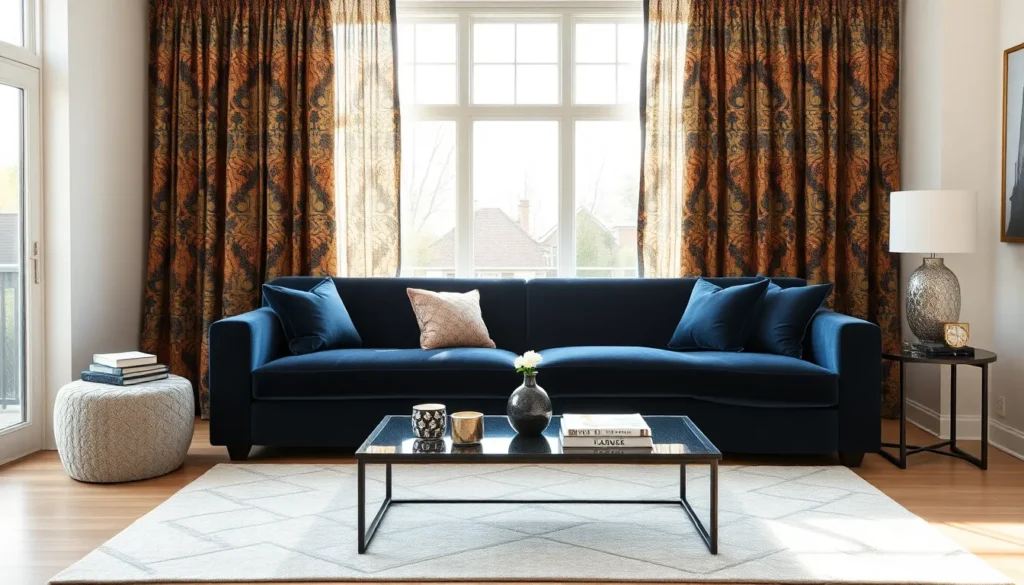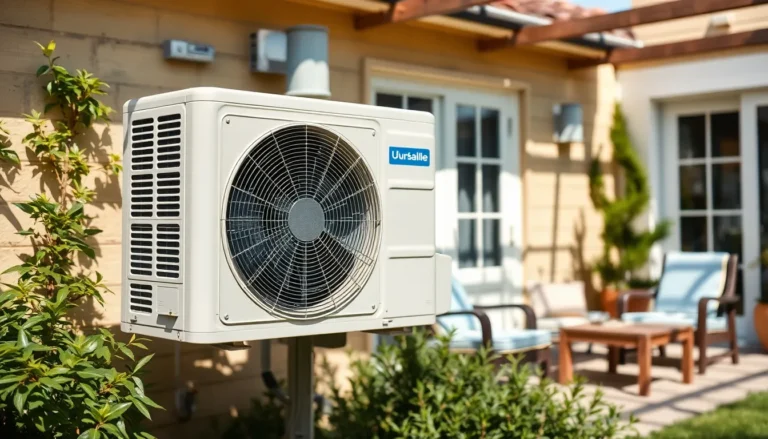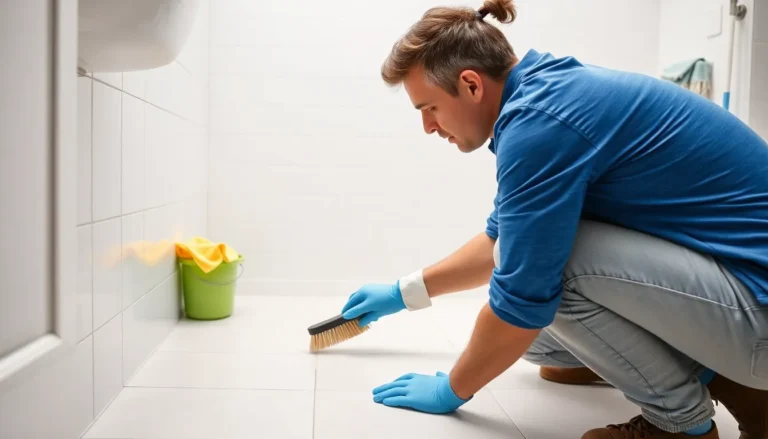When it comes to transforming a space, interior fabrics are the unsung heroes. They can take a room from drab to fab faster than you can say “throw pillow.” Whether it’s a luxurious velvet sofa or a quirky patterned curtain, the right fabric can add personality and warmth, making any space feel like home.
Table of Contents
ToggleOverview of Interior Fabrics
Interior fabrics play a crucial role in defining the aesthetic and functionality of a space. Traditional materials like cotton and linen offer a classic appeal, while modern options such as microfiber or performance fabrics provide durability and ease of maintenance.
Textures add depth and dimension to interiors. Velvet’s plush feel contributes to a luxurious atmosphere, while leather offers sophistication. Options like burlap or jute lend an organic touch, enhancing rustic or farmhouse designs.
Patterns introduce visual interest. Floral designs can create a cheerful ambiance, while geometric shapes often lend a contemporary flair. Stripes offer versatility, easily integrating with various styles.
Colors influence mood and perception. Warm tones, like reds and oranges, energize a space, while cooler shades, such as blues and greens, evoke calmness. Neutral colors act as a backdrop, allowing bolder elements to shine.
Fabrics must also consider practical aspects. Heavy drapes can provide insulation and privacy, while lightweight sheers allow natural light. Upholstery fabrics should withstand wear and tear, especially in high-traffic areas.
Sustainability emerges as a vital factor. Eco-friendly materials, like organic cotton and recycled fabrics, appeal to environmentally conscious consumers. Innovations in fabric technology also lead to better durability and stain resistance.
Finally, the right combination of fabrics can cohesively tie a room together. Layering different textiles, like cushions and throws, enhances comfort and style. Selecting complementary fabrics elevates the overall design, creating harmonious and inviting spaces.
Types of Interior Fabrics

Interior fabrics can be broadly categorized into natural and synthetic options, each offering unique characteristics and benefits.
Natural Fabrics
Natural fabrics include materials sourced from plants or animals. Cotton remains popular due to its softness and breathability; it’s ideal for casual spaces like bedrooms and living rooms. Linen, known for its texture and durability, adds an effortless elegance to interiors. Wool offers warmth and insulation, making it a favorite for cozy environments. Silk brings luxury and sheen, perfect for accent pieces or drapes. Bamboo fabric, often overlooked, provides eco-friendliness and antimicrobial properties that appeal to sustainability-conscious designers. Each type contributes a distinct feel and visual aesthetic, creating inviting atmospheres.
Synthetic Fabrics
Synthetic fabrics are created from chemical compounds, offering durability and practicality. Polyester, for example, resists wrinkles and fading, making it an excellent choice for high-traffic areas. Nylon also provides strength and wear resistance, suitable for upholstery that endures daily use. Acrylic mimics wool’s warmth while being lightweight and less expensive. Microfiber stands out for its stain resistance and softness, ideal for families with children or pets. Vinyl’s waterproof qualities make it popular for outdoor furniture and easy-to-clean surfaces. These options expand design possibilities while meeting various functional needs.
Choosing the Right Interior Fabric
Selecting the appropriate interior fabric involves considering various factors that enhance both functionality and style. Prioritizing durability and ease of maintenance ensures fabrics withstand daily use while maintaining their appearance.
Durability and Maintenance
Durable fabrics resist wear and tear, making them ideal for high-traffic areas. Polyester and nylon rank among the strongest options, often featuring stain-resistant treatments. Additionally, microfiber offers exceptional durability while being easy to clean. Regular maintenance, like vacuuming or spot cleaning, extends the life of these fabrics. It’s crucial to read care labels since fabric specifics dictate cleaning methods and longevity. Convenience matters; choosing synthetic options often results in less time spent on maintenance.
Aesthetic Appeal
Aesthetic appeal heavily influences the choice of interior fabrics. Color plays a significant role; warm tones can energize a room, while cool colors create calmness. Patterns, such as floral or geometric, add character to surfaces like furniture or curtains. Textures, including plush velvet or smooth silk, contribute to depth and warmth in a space. Natural fabrics can enhance elegance, whereas bold synthetic designs cater to modern aesthetics. Harmonizing fabric choices with existing decor amplifies visual appeal. Each fabric type serves to complement the overall design, creating a cohesive and inviting atmosphere.
Popular Trends in Interior Fabrics
Current trends in interior fabrics focus on sustainability and functionality. Eco-friendly materials gain popularity, with fabrics made from organic cotton and recycled polyester leading the way. Vibrant colors, such as rich jewel tones, become popular choices for upholstery and accessories, creating visual drama in living spaces.
Texture plays a significant role in contemporary design. Soft textures like bouclé and plush chenille add warmth to spaces while inviting touch. Layering different textiles enhances depth and interest, creating well-designed interiors.
Patterned fabrics also see a resurgence, with bold prints and geometric designs catching the eye. Floral patterns add a touch of nature indoors, while abstract designs bring modern flair. Mixing patterns creates a personalized aesthetic, showcasing individual style preferences.
The demand for multifunctional fabrics rises, with materials that resist stains and wear gaining traction. Performance fabrics such as solution-dyed acrylic and stain-resistant treated textiles offer durability suitable for high-traffic areas.
Natural fibers continue to maintain their appeal, with from linen’s breathability to wool’s warmth. These materials cater to both comfort and practicality while enhancing the overall design aesthetics.
Innovations in fabric technology enable improved breathability and moisture management, making textiles more functional for modern living. Smart fabrics, with built-in temperature regulation and odor resistance, emerge as exciting new options in interior design.
Staying updated on these trends helps create beautiful, functional spaces that resonate with current design standards and lifestyles.
Interior fabrics play a vital role in shaping both the aesthetics and functionality of any space. By carefully selecting materials that align with personal style and practical needs, individuals can create inviting environments that reflect their unique tastes. As trends shift toward sustainability and multifunctional designs, the right fabric choices can enhance not only the visual appeal but also the longevity of interiors. Embracing a mix of textures, colors, and patterns allows for a dynamic atmosphere that feels both comfortable and stylish. Ultimately, the thoughtful integration of interior fabrics can transform a house into a true home.






